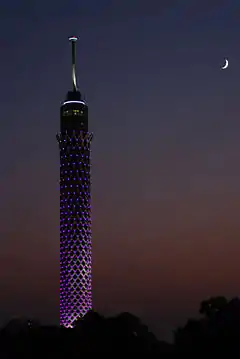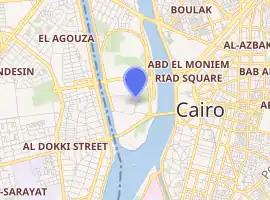Cairo Tower
The Cairo Tower (Egyptian Arabic: برج القاهرة, Borg El-Qāhira) is a free-standing concrete tower in Cairo, Egypt. At 187 m (614 ft), it is the tallest structure in Egypt and North Africa. It was the tallest structure in Africa for ten years until 1971, when it was surpassed by Hillbrow Tower in South Africa.
| Cairo Tower | |
|---|---|
Arabic: برج القاهرة Borg El-Qahira | |
 Cairo tower in 2008 | |

| |
| General information | |
| Status | Complete |
| Type | Communications, observation, restaurants, visitor attraction |
| Architectural style | Ancient Egypt |
| Location | Cairo, Egypt |
| Coordinates | 30°02′45″N 31°13′28″E |
| Construction started | 1956 |
| Completed | 1961 |
| Opening | 1961[1] |
| Cost | Around $US1-3 million |
| Owner | Government of Egypt |
| Height | |
| Architectural | 187 m (613.5 ft) |
| Antenna spire | 187 m (613.5 ft) |
| Roof | 160 m (524.9 ft) |
| Top floor | 143 m (469.2 ft) |
| Observatory | 143 m (469.2 ft) |
| Technical details | |
| Material | Concrete |
| Floor count | 62 |
| Lifts/elevators | 3 |
| Design and construction | |
| Architect | Naoum Shebib |
| Website | |
| cairotower.net (requires Adobe Flash; in English) | |
| References | |
| [2][3][4][5][6][7] | |
One of Cairo's well-known modern monuments, sometimes considered Egypt's second most famous landmark after the Pyramids of Giza, it stands in the Gezira district on Gezira Island in the River Nile, close to downtown Cairo.
History
Built from 1956 to 1961, the tower was designed by the Egyptian architect Naoum Shebib, inspired by the Ancient Egyptian Architecture.[1] Its partially open lattice-work design is intended to evoke a pharaonic lotus plant, an iconic symbol of Ancient Egypt.[8] The tower is crowned by a circular observation deck and a revolving restaurant[9] that rotate around its axis occasionally[10] with a view over greater Cairo.[11]
According to documents published by Major General Adel Shaheen, the funds for the construction of the tower were originated from the Government of the United States through the CIA that represented by Kermit Roosevelt, which had provided around $US1-3 million to Gamal Abdel Nasser as a personal gift to him with the intent of stopping his support for Algerian Revolution and other African independence movements.[8][12][13] Affronted by the attempt to bribe him, Nasser decided to publicly rebuke the U.S. government by transferring all of the funds to the Egyptian government for the use of the tower construction, which he stated that it would be "visible from the US Embassy just across the Nile, as a taunting symbol of Egypt's, Africa and the Middle East's resistance, revolutions and pride".[12][14]
The book also stated that the General Intelligence Service took full responsibility for everything related to the design and planning work, including the selection of the architect who was assigned to design, the construction work, and even providing the necessary materials for the building with the aim of giving the heroic character of the president.[8] However, its design was controversial that the Egyptians called it as the "waqf Roosevelt" ("Roosevelt's endowment"), which then mistakenly interpreted by the Embassy of Egypt in Washington, D.C. as the "waqef Roosevlet" ("Roosevelt's erection"). Thus, prompted the Americans to react by calling it as the "Nasser's prick".[13] Because of that, a local Islamic group issued a fatwa to demolish the tower in the 1990s, stating that it "could excite Egyptian women", but this was failed to be implemented due to its influence on national history and popularity among the nation and tourists.[15][16]
Between 2006 and 2009, the tower underwent an EGP 15 million restoration project that included a new installation of light decoration. It was stated that the project used the LED lamp for its efficiency on energy consumption.[17]
Gallery
 Cairo Tower Entrance
Cairo Tower Entrance Cairo Tower from below
Cairo Tower from below.jpg.webp) Cairo Tower
Cairo Tower Cairo Tower at sunset
Cairo Tower at sunset
See also
References
Citations
- Dunn, Jimmy. "The Cairo Tower in Cairo Egypt". touregypt.com. Retrieved 10 April 2014.
- "Cairo Tower". The Skyscraper Center. Council on Tall Buildings and Urban Habitat. Retrieved 13 September 2020.
- "Cairo Tower". emporis.com. Emporis. Retrieved 13 September 2020.
- "Cairo Tower". skyscraperpage.com. SkyscraperPage. Retrieved 13 September 2020.
- "Cairo Tower in Cairo". phorio.com. Phorio. Retrieved 13 September 2020.
- "Cairo Television Tower". structurae.net. Structurae. Retrieved 13 September 2020.
- Heinle & Leonhardt 1997, p. 243.
- Raouf, Ali Abdul (9 April 2017). "الأسطورة والزعيم والمبنى". Aljazeera.net (in Arabic). Retrieved 12 September 2020.
- "Cairo Tower". LonelyPlanet.com. Retrieved 12 September 2020.
- "Cairo Tower". egypt.travel. Egyptian Tourism Authority. Retrieved 13 September 2020.
- Huiwo, Wu (25 November 2019). "Scenery Seen from Cairo Tower". xinhuanet.com. Xinhua News Agency. Retrieved 13 September 2020.
- Abdulaal, Mirna (1 November 2019). "How the Cairo Tower Gave Birth to Modern Egypt". EgyptianStreets.com. Retrieved 12 September 2020.
- Raafat, Samir (16 October 1997). "The Cairo Tower". egy.com. Cairo Times. Archived from the original on 15 June 2008. Retrieved 21 March 2005.
- Mousa, Sarah. "Commemorating the United Arab Republic". Al Jazeera. Retrieved 5 March 2017.
- Richardson 2013, section 16.
- Halime, Farah (17 May 2016). "Egyot's Giant Middle Finger to America". ozy.com. Ozy. Retrieved 10 September 2016.
- Ramadan, Ahmed (20 June 2010). "New Lighting Puts Cairo Tower Back on the Map". Egypt Independent. Retrieved 13 September 2020.
Books
- Richardson, Dan (2013). Cairo and the Pyramids (Rough Guides Snapshot Egypt). London: Rough Guides UK. ISBN 9781409335443. OCLC 1052041050.CS1 maint: ref=harv (link)
- Heinle, Erwin; Leonhardt, Fritz (1997). Türme aller Zeiten - aller Kulturen (in German) (3rd ed.). Stuttgart: Deutsche Verlags-Anstalt. ISBN 9783421029317. OCLC 258633921.CS1 maint: ref=harv (link)
External links
| Wikimedia Commons has media related to Cairo Tower. |
- cairotower.net, tower's official website (requires Adobe Flash; in English)